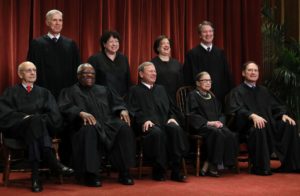In 1972, John and Bernadine Suitum bought a small lot in Incline Village, a residential subdivision near beautiful Lake Tahoe. John fell ill, and as Bernadine cared for him over the last few years of his life, the rest of the subdivision was permitted and developed.
After John’s death, Bernadine, now an elderly widow, finally decided to build a small home near the lake. In order to do so, Bernadine needed permission from the Tahoe Regional Planning Agency (TRPA), an agency tasked in 1969 with controlling land use in the Lake Tahoe basin. Using its significant regulatory power, TRPA has long been a thorn in the side of property owners simply wishing to make productive use of their own land.
Bernadine was no exception. TRPA denied her permit, saying a small drainage ditch that ran behind her property made the lot unsuitable for building—even though bureaucrats had previously approved development for every other lot in the subdivision.
Bernadine was told that the government had since all new development was prohibited in the area and all she could get were “transferable development rights,” or TDRs.
Used by governments all over the country to avoid paying for property takings, TDRs are essentially coupons given to property owners who could, in theory, use them to build somewhere else or sell to another developer. In reality, there is virtually no market for TDRs, which makes them worthless. Even if Bernadine could find a buyer for her imaginary currency, she would still need TRPA’s approval to sell her TDRs.
Worse, had Bernadine been able to develop her lot, it would have been worth about $200,000. TRPA, however, valued her TDRs at only $30,000.
Governments can’t use TDRs or any other type of gimmicky substitute as a magical “get out of just compensation free” card. But when Bernadine took TRPA to federal court to challenge the denial of her right to build on her land as a taking, the agency argued she wasn’t yet entitled to her day in court because she hadn’t tried to sell the credits.
Both the trial court and Ninth Circuit Court of Appeals agreed with the government, saying that until she actually used her TDRs, there was no way to determine what they were worth or, in turn, if her property had been unlawfully taken.
In 1997, Pacific Legal Foundation represented Bernadine before the Supreme Court. During oral argument, Chief Justice William Rehnquist compared the government’s so-called credits to casino chips Bernadine should either use herself or hawk to other gamblers:
“It seems to me your argument is: if the TRPA says you can’t use your lot but here’s some [credit], you go over to Harrah’s and you can play roulette with it. Then you say, no, we don’t value the [credit]. We require the owner to stand outside the door of Harrah’s and see what she can get for it though.”
Justice Sandra Day O’Connor asked, “My goodness. I mean, why not give this poor, elderly woman the right to go to court and have her takings claim heard?”
The Court ultimately rejected the government’s argument. In their unanimous decision, the Justices ruled that TRPA’s decision was finaland could be challenged as a taking. It remanded the case to allow Bernadine to defend her property rights in court without agreeing to the absurd demand that she first try to use the made-up credits.
Six years after she first sued TRPA, and at age 82, Bernadine finally won the opportunity to have a district court consider whether government violated her constitutional rights.
By wiping away procedural hurdles blocking landowners from the courthouse doors, Suitum has since been immensely important for anyone who needs to sue the government to protect their property.
What’s At Stake?
- If a government wants to take a piece of land for any reason, it must pay for it. The government cannot avoid its obligation to pay just compensation with gimmicks such as transferrable development rights.
Case Timeline
No files available.
FOR MEDIA INQUIRES:
Attorneys
No assigned attorney at the moment










